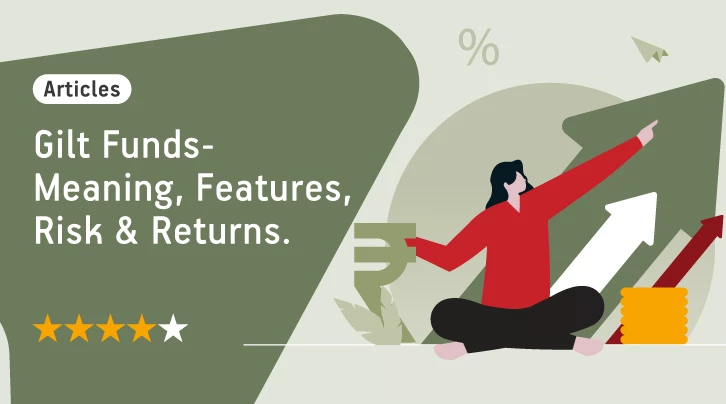As per SEBI categorisation of mutual funds, there are 16 types of debt funds in India, GILT funds being one of them. Read this post to know what they are, how they work, and more.
The government borrows funds from the financial markets to meet its fiscal deficit through G-Secs (Government Securities). The securities are either long-term or short-term, depending on their maturities.
Dated Securities or Government Bonds are known as long-term securities as they have a maturity of 1 year or above. Then there are short-term securities like T-Bills (Treasury Bills) with maturities of less than a year. Individual investors can invest in these government securities through the newly launched RBI Retail Direct portal. Many stockbrokers also offer access to these securities.
Alternatively, investors can consider investing in GILT funds to take advantage of these low-risk securities. Let's take a look at what is GILT fund, how it works, and more-
1. What are GILT Funds in India?
There are 16 different types of debt mutual funds in India. While debt funds are known for their lower potential risk, the risk level varies between these 16 categories. GILT funds fall at the lower end of the risk spectrum.
These mutual funds invest at least 80% of their portfolios in G-Secs across maturities. As the majority of the investment is done in securities backed by the government, these schemes are known to carry minimal risk.
2. How Do GILT Funds Work?
Here’s a quick overview of how GILT funds work-
1. The government wants to borrow funds to meet the fiscal deficit
2. The RBI collects the required amount from entities like banks and insurance companies
3. The RBI lends the collected money to the government
4. Against the loan amount, the RBI issues G-Secs with fixed maturities
5. Fund managers of GILT funds subscribe to such securities to generate interest income
6. On maturity, the G-Secs are returned to the RBI, which then pays the pre-fixed interest
While GILT funds mostly invest in government securities known to have virtually zero non-payment risk, the schemes are not risk-free. Government borrowing is generally for longer durations, due to which there is always an interest rate risk in these funds.
3. Who Should Invest in GILT Funds?
You can consider investing in a GILT fund if-
You are a Risk-Averse Investor
If you are a risk-averse investor who is not comfortable investing in debt funds like bond funds or credit risk funds, where the majority of the investment is done in corporate bonds, you can consider investing in a GILT mutual fund. With this fund, at least 80% of the total assets of the investment will be done in government-backed securities which don’t have credit risks.
You Want to Build a Diversified Portfolio
It is important to build a diversified portfolio and avoid overexposure to any particular asset class to keep the risk to a minimum. If you follow a similar investing ideology, GILT funds can be an addition to your portfolio as they can provide you with access to low-risk government securities.
You Have an Investment Horizon of 3-5 Years
GILT funds can be ideal for medium-term investment tenures ranging from 3-5 years or more. If you want to park your funds for the said duration GILT mutual funds deserve a spot in your portfolio.
4. What factors should you consider before investing in GILT Funds?
Invest in GILT funds after thoroughly analysing the following-
Risk Factor
The government pays interest on the amount it borrows from the RBI. As the government generally never fails to fulfil its payment obligations, these schemes don't carry credit risks. However, they are highly sensitive to interest rate fluctuations. If there is a sharp rise in the interest rates, it can significantly impact the returns generated by these schemes.
TER
TER, or Total Expense Ratio, is the management fee charged by the fund houses. When selecting a GILT fund, choose one with a low TER; a higher TER will negatively impact your returns. If not the lowest, the TER of the chosen scheme should at least be in line with the category average.
Include GILT Funds in Your Portfolio
Understanding the GILT fund meaning and how they work is essential to make an informed investment decision.
GILT funds can be an investment option for a risk-averse investor. You can also consider investing in these schemes to build a diversified portfolio.
Mutual Fund investments are subject to market risks, read all scheme related documents carefully.





 1800-270-7000
1800-270-7000




